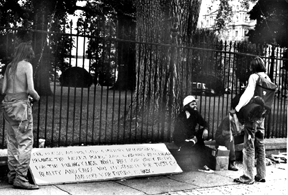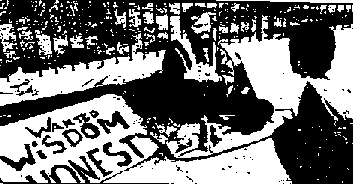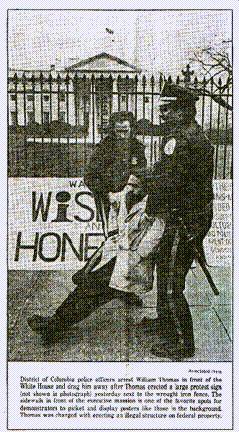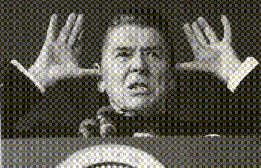
1981-85:
Reagan Years
1981 | 1982 | 1983 | 1984
Reagan's Second Term (1981-85)
Bush - Clinton
At the time
the round-the-clock vigil began -- on June 3, 1981 -- it was five months after Reagan's first
inauguration. People were still allowed to demonstrate on the White House sidewalk.

But
Ronald Reagan's "trickle-down" theories required that
traditions be rewritten. In January, 1983, Department of Interior
Secretary James Watt penned a memo
declaring his intent to ban demonstrations from the White House
sidewalk AND Lafayette Park. The CCNV
folks were arrested for their tents
in the park. And the unsheltered
peace vigilers were simultaneously
arrested on the White House sidewalk, also charged with "camping."
In those days the judges were still throwing
camping cases out of court.
 After a February-April 1983 campaign
by the Washington Times (Reagan
loved the Washington Times), new
regulations were written banishing
vigils from the White House sidewalk
across the street to Lafayette Park.
But this didn't solve the DOI's problem. The vigil continued.
U.S. Park Police and DOI lawyers
continued working together to
make remaining in the park extremely uncomfortable
(even though 24-hour vigils are
expressly permitted), using the recently-published "camping" regulation over and
over to criminalize
what was formerly protected behavior.
During the wee hours of the mornings, when tourists weren't
about, U.S. Park Police lurked, threatened, and often arrested
the vigilers (sometimes brutally).
When drunk marines or Young
Americans for Freedom pranksters
attacked the vigilers,
the police usually were nowhere to be found. In court, several
officers lied. At least
one friendly officer later apologized for arresting us, explaining
he was "just following orders." At that time, their
boss was Deputy Chief Lindsey,
who took a continuing personal interest
in removing the "problem" from the park.
After a February-April 1983 campaign
by the Washington Times (Reagan
loved the Washington Times), new
regulations were written banishing
vigils from the White House sidewalk
across the street to Lafayette Park.
But this didn't solve the DOI's problem. The vigil continued.
U.S. Park Police and DOI lawyers
continued working together to
make remaining in the park extremely uncomfortable
(even though 24-hour vigils are
expressly permitted), using the recently-published "camping" regulation over and
over to criminalize
what was formerly protected behavior.
During the wee hours of the mornings, when tourists weren't
about, U.S. Park Police lurked, threatened, and often arrested
the vigilers (sometimes brutally).
When drunk marines or Young
Americans for Freedom pranksters
attacked the vigilers,
the police usually were nowhere to be found. In court, several
officers lied. At least
one friendly officer later apologized for arresting us, explaining
he was "just following orders." At that time, their
boss was Deputy Chief Lindsey,
who took a continuing personal interest
in removing the "problem" from the park.
 On January 25, 1984, President Reagan said in his State
of the Union address,"send
away the doubting Thomases." On January 31, 1984, Thomas
and Concepcion were arrested. Charges were dropped soon after
Reagan was served with a motion for discovery.
DOI lawyer DOI lawyer Richard
Robbins closely advised the Park Police how the ever-more-complicated
regulations should be interpreted.
In November 1984 Thomas, Concepcion, and Ellen filed a
lawsuit trying to put
a stop to police misconduct under cover of the DOI regulations.
Becoming plaintiffs rather than defendants put them in a slightly
more favorable position in the media
as well as in court. Police became slightly more circumspect.
It took prosecutors four more years and another regulation to
find a judge who would reluctantly
send the vigilers to prison
for three months on "camping" tickets issued by
order of superiors.
On January 25, 1984, President Reagan said in his State
of the Union address,"send
away the doubting Thomases." On January 31, 1984, Thomas
and Concepcion were arrested. Charges were dropped soon after
Reagan was served with a motion for discovery.
DOI lawyer DOI lawyer Richard
Robbins closely advised the Park Police how the ever-more-complicated
regulations should be interpreted.
In November 1984 Thomas, Concepcion, and Ellen filed a
lawsuit trying to put
a stop to police misconduct under cover of the DOI regulations.
Becoming plaintiffs rather than defendants put them in a slightly
more favorable position in the media
as well as in court. Police became slightly more circumspect.
It took prosecutors four more years and another regulation to
find a judge who would reluctantly
send the vigilers to prison
for three months on "camping" tickets issued by
order of superiors.
NEXT: Reagan's Second Term (1985-89)
Current Situation
1776-1980 | 1981 | 1985 | 1989 | 1993 | 1997
Regulations | Park Closures | Pennsylvania Ave. Closure
Legal Overview | Peace Park | Proposition One




